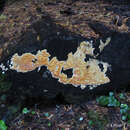pt-BR
nomes no trilho de navegação


Phellinus weirii is a plant pathogen causing laminated root rot in certain conifers, typically Douglas-fir and western redcedar.[2] It is widespread in the Douglas-fir growing regions of British Columbia, Washington and Oregon.[3]
Symptoms of fungal infection are readily recognized when timber is cut because a brown stain will appear on the butt cut. In early stages it will be just a spot in the heart wood, but as the disease advances it will extend most of the way around the heart wood, and in extreme cases may result in a hollow stump. Usually it is not observed more than a few feet above ground level.
Losses due to the fungus are estimated at 4.4 million m3 (157 million ft3) of timber in the Northwestern United States and in British Columbia.[4]
Reduced growth rate is an attribute of tree infection.[5] Particular attention is invited to the growth ring patterns visible in the images attached.
Close up of Phellinus weirii infection at Apiary, Oregon
Phellinus weirii is a plant pathogen causing laminated root rot in certain conifers, typically Douglas-fir and western redcedar. It is widespread in the Douglas-fir growing regions of British Columbia, Washington and Oregon.
Phellinus weirii je grzib[6], co go nojprzōd ôpisoł William Alphonso Murrill, a terŏźnõ nazwã doł mu Robert Lee Gilbertson 1974. Phellinus weirii nŏleży do zorty Phellinus i familije Hymenochaetaceae.[7][8] Żŏdne podgatōnki niy sōm wymianowane we Catalogue of Life.[7]
Phellinus weirii je grzib, co go nojprzōd ôpisoł William Alphonso Murrill, a terŏźnõ nazwã doł mu Robert Lee Gilbertson 1974. Phellinus weirii nŏleży do zorty Phellinus i familije Hymenochaetaceae. Żŏdne podgatōnki niy sōm wymianowane we Catalogue of Life.